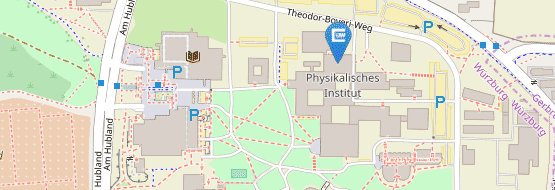Würzburg ToCoTronics Colloquium
Coexistence of Superconductivity and Chiral Charge Density Wave in TiSe₂
| Datum: | 03.09.2025, 15:00 - 17:00 Uhr |
| Ort: | Hubland Süd, Geb. P1 (Physik), HSP P (Röntgen HS) |
| Veranstalter: | SFB 1170 ToCoTronics |
| Vortragende: | Prof. Dr. Goran Karapetrov - Drexel University |
Chirality breaks down the inversion symmetry and results in unexpected new electronic properties in systems with reduced dimensionality. Stark examples of manifestation of chirality on electronic properties of materials are carbon nanotubes. In addition to structural chirality, the chiral state can also manifest itself in the arrangement of electronic states – magnetic vortices, skyrmions, chiral superconductors. TiSe2 is the first known transition metal dichalcogenide that exhibits chiral charge density wave state.
We demonstrate the chiral properties of the CDW through several independent techniques: scanning probe microscopy, transient optical reflectivity and photogalvanic effect. As temperature is decreased below TCDW=200 K 1T-TiSe2 goes first from the high temperature normal phase to a 2 × 2 × 2 achiral CDW phase at TCDW and then to a chiral phase at Tch. These two thermodynamic transitions were first observed using bulk thermodynamic techniques [1], and their nature explored in more detail using photogalvanic effect [2]. The structure of the chiral CDW was imaged using scanning tunneling microscopy [3], while time-resolved optical reflectivity and IR studies clearly show that the chiral order can be non-thermally melted and controlled using circularly polarized light. Further studies using X-ray photon correlation spectroscopy show that the charge density wave has distinct dynamics near the transition temperature [4].
The spontaneous emergence of chirality in the correlated semimetal TiSe2 can be utilized to create spin-polarizated currents. Optical control over charge chirality and resulting spin-polarized currents could enable novel orders in quantum materials and provide opportunities for new electrooptical devices.
[1] J.-P. Castellan, S. Rosenkranz, R. Osborn, Q. Li, K. E. Gray, X. Luo, U. Welp, G. Karapetrov, J. P. C. Ruff, & J. van Wezel, Phys.Rev.Lett, 110 196404 (2013).
[2] S.-Y. Xu, Q. Ma, Y. Gao, A. Kogar, G. Zong, A. M. M. Valdivia, T. H. Dinh, S.-M. Huang, B. Singh, C.-H. Hsu, T.-R. Chang, J. P. C. Ruff, K. Watanabe, T. Taniguchi, T.-R. Chang, H. Lin, G. Karapetrov, D. Xiao, P. Jarillo-Herrero, & N. Gedik, Nature 578 545 (2020).
[3] M. Iavarone, R. Di Capua, X. Zhang, M. Golalikhani, S. A. Moore, & G. Karapetrov, Physical Review B, 85 155103 (2012).
[4] T. Sutter, C. Lindenau, S. Sharma, A. Fluerasu, L. Wiegart, G. Karapetrov, A. Kogar, X. M. Chen, arXiv:2504.03176


